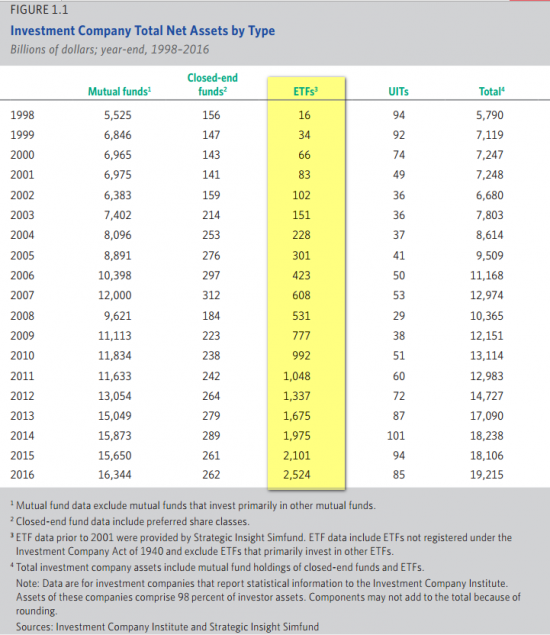Блог им. sarmat_ |А у нас ETF, а у Вас? А у нас в квартире газ )
- 18 июня 2017, 11:41
- |
Рассматривая последний отчёт «A Review of Trends and Activities in
the Investment Company Industry» обратил внимание на то какими темпами растут ETF фонды:

Отличие ETF от Mutual Fund приведу с отчёта:
Key Differences
One major difference is that retail investors buy and sell ETF shares on the secondary
market (stock exchange) through a broker-dealer, much like they would any other type
of stock. In contrast, mutual fund shares are not listed on stock exchanges, but are
purchased and sold through a variety of distribution channels, including through investment
professionals—full-service brokers, independent financial planners, bank or savings institution
representatives, or insurance agents—or directly from a fund company or discount broker.
Pricing also differs between mutual funds and ETFs. Mutual funds are “forward priced,”
which means that although investors can place orders to buy or sell shares throughout the
day, all orders placed during the day will receive the same price—the NAV—the next time it
is computed. Most mutual funds calculate their NAV as of 4:00 p.m. eastern time because
that is the time US stock exchanges typically close. In contrast, the price of an ETF share is
continuously determined on a stock exchange. Consequently, the price at which investors
buy and sell ETF shares on the secondary market may not necessarily equal the NAV of the
portfolio of securities in the ETF. Two investors selling the same ETF shares at different times
( Читать дальше )
- комментировать
- ★1
- Комментарии ( 10 )
- bitcoin
- brent
- eurusd
- forex
- gbpusd
- gold
- imoex
- ipo
- nasdaq
- nyse
- rts
- s&p500
- si
- usdrub
- wti
- акции
- алготрейдинг
- алроса
- аналитика
- аэрофлот
- банки
- биржа
- биткоин
- брокеры
- валюта
- вдо
- волновой анализ
- волны эллиотта
- вопрос
- втб
- газ
- газпром
- гмк норникель
- дивиденды
- доллар
- доллар рубль
- евро
- золото
- инвестиции
- индекс мб
- инфляция
- китай
- кризис
- криптовалюта
- лукойл
- магнит
- ммвб
- мобильный пост
- мосбиржа
- московская биржа
- мтс
- нефть
- новатэк
- новости
- обзор рынка
- облигации
- опрос
- опционы
- отчеты мсфо
- офз
- оффтоп
- прогноз
- прогноз по акциям
- путин
- раскрытие информации
- ри
- роснефть
- россия
- ртс
- рубль
- рынки
- рынок
- санкции
- сбер
- сбербанк
- северсталь
- си
- сигналы
- смартлаб
- сущфакты
- сша
- технический анализ
- торговля
- торговые роботы
- торговые сигналы
- трамп
- трейдинг
- украина
- фондовый рынок
- форекс
- фрс
- фьючерс
- фьючерс mix
- фьючерс ртс
- фьючерсы
- цб
- цб рф
- экономика
- юмор
- яндекс



















